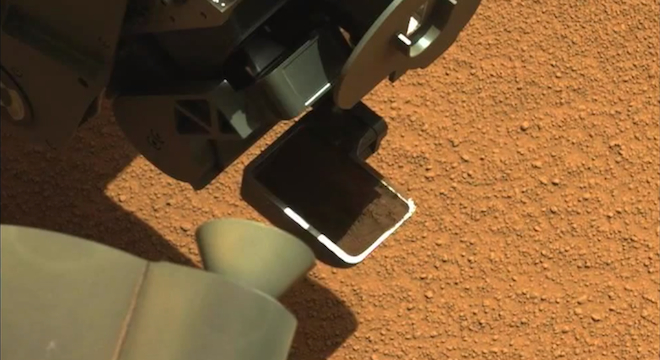Updated 10:40 a.m. EDT, Tuesday, October 9
NASA’s Mars Curiosity Rover has reached down and picked up its first bit of the Red Planet, NASA announced Monday.
As planned, Curiosity scooped its first sample of Martian sand on Sunday using its Collection and Handling for In-Situ Martian Rock Analysis (CHIMRA), a multi-purpose instrument on the end of the rover’s 7-foot-long robotic arm.
The scoop — which will be the first of at least four at the rover’s current location — left behind a visible hole in the Martian sand at the rover’s current site, an area dubbed “Rocknest” for the prevalence of boulders observed by the rover.
NASA published the following full color video of the sample just after the scooping operation, as taken by the rover’s mast camera (Mastcam). The video is made up of 256-individual frames captured at 8-frames-per second but sped-up in this view to 32-frames-per-second:
NASA noted Monday that the rover vibrates the scooper slightly after each sample to make it level.
Curiosity’s left navigational camera (Navcam) captured the following black-and-white image of the hole left behind by the scooper, which NASA also posted online Monday:

The CHIMRA includes the 4.5-centimeter wide scooper tool as well as the vibration mechanism, which, aside from leveling the samples, rapidly shakes sand throughout the entire rover hand, an exercise NASA needs to do three times to clean off Earth-based oily residue from the rover’s instruments so that it can begin analyzing the Martian soil samples.
The fourth scoop of Martian soil is the one NASA is aiming to run through its full battery of tests, including the Chemistry and Mineralogy (CheMin) and Sample Analysis at Mars (SAM) instruments, which NASA notes will be able to tell whether the sample area ever had conditions favorable to life.
Already, Curiosity has uncovered evidence of an ancient Martian streambed, now long since dried-up but where liquid water most likely flowed in abundance for a sustained period of time, displacing rocks, eroding and them and smashing them together. Water, especially running water, is one of three key ingredients NASA is looking for when it comes to determining the planet’s conditions of habitability, which is the aim of the Mars Curiosity mission (also known as the Mars Science Laboratory). The other two are evidence of carbon-based life and sources of energy to sustain microbial life.
NASA’s Mars Curiosity Rover has driven 1,590 feet, or over a quarter of a mile, since landing on the Martian surface on August 6. It will remain and its current site, Rocknest, for the next two to three weeks while conducting further scooping operations, and then move on to its first official science target, an area of strange Martian geology known as Glenelg.
Late update: NASA late Monday published a new, wider full-color image captured by the rover showing an unidentified shiny, tiny object in the Martian soil just below and to the side of the rover. NASA scientists aren’t sure yet what it is, but suspect it may be a piece of hardware that fell off the rover. See an annotated image of the object below via NASA (annotated by TPM) and the original here.

Curiosity’s science team has suspended further scooping activities as it gathers closer-up and more detailed imagery of the object.






